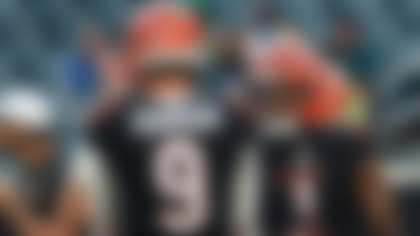Every offseason, one of my favorite tasks is to scour every NFL roster and identify the most underappreciated player on each team using my context-based models. In the fast-paced NFL season, it's easy to focus on superstars or skill-position players who help us win in fantasy football, but one of the most useful applications of analytics is to view every game from the previous campaign through the lens of a total-contribution metric to see where teams earned an edge that perhaps didn't receive as much attention as it should have during the season.
With that in mind, here's how I come up with my list of the most underappreciated players:
First, I calculate and then rank each player's season-long contribution metric by team (win share). To sum it up without getting overly technical, the contribution metric (or win share) measures each player's production during the previous season. The metric encompasses a value for every snap by each player and reveals each player's contribution to the team's overall win total. After making those calculations, I factor in each player's salary by position (contract data via Over The Cap) to add some context around who was being "underappreciated." I always try to give priority to players who have not switched teams in the current offseason (since it's harder to be underappreciated by a team you haven't played for yet), but that keeps getting harder to do, due to tons of free-agent movement. Then I weight players drafted in Round 2 or later who have been to no more than two Pro Bowls and aren't in the top 10 at their position. That said, the most critical component to this entire method remains the contribution metric.
Just like I did in this space for the past three years, I'm providing one player from each NFC team that my model flagged as being underappreciated.
NOTE: Players are listed with the ages they will be as of Sept. 7, when the 2023 NFL season is set to kick off.

Average salary per year (APY): $2.25 million (81st among wide receivers).
It's typically a good sign when a coach changes teams and immediately adds a familiar face to his new roster. That's what Jonathan Gannon did with Pascal. The veteran wideout doesn't figure to be a fantasy monster with the Cardinals, but he gives the transitioning team a physical and reliable presence both in the slot and out wide. Last season in Philadelphia, Pascal was targeted on just four passes of 10-plus air yards, catching two for 45 yards. The small sample size is hardly surprising, given that he was in the same receiving corps as A.J. Brown, DeVonta Smith and tight end Dallas Goedert. But if you look at the three seasons prior to that when Pascal was in Indianapolis, he received a combined 105 such targets, catching 50 and scoring nine touchdowns. That completion percentage of 47.6 on such throws ranks ahead of star WRs like Mike Williams, Terry McLaurin and D.J. Moore during the 2019-2021 span. Furthermore, Pascal impacts the game when he's not getting targeted, too. According to PFF's grading, the wideout was the third-best run blocker on the 2022 Eagles, behind only center Jason Kelce and left tackle Jordan Mailata.

APY: $998,472 (rookie contract; 95th among running backs).
I totally understand (and share in) the anticipation of seeing how Arthur Smith will exploit Bijan Robinson's special skill set. That said, I don't think the Falcons plan to completely ditch Tyler Allgeier and Cordarrelle Patterson by handing the entire RB workload to the rookie. Don't be surprised if Allgeier and Robinson are on the field together somewhat regularly. In 2022, Allgeier led all rookies with 154 rushing yards over expected, per NGS. His 170 rushing yards over expected on rushes outside the tackles were the fourth-most among all backs, and his 3.9 yards after contact per carry ranked sixth in the league.

APY: $1.048 million (rookie contract; 85th among running backs).
Hubbard took a big step forward as a runner and receiver in 2022, with major bumps in yards per carry (4.9, up from 3.6 in 2021) and yards per reception (12.2, up from 7.0). And he averaged 5.0 yards per rush between the tackles last year, per Next Gen Stats, tying for eighth in the league. While free-agent acquisition Miles Sanders forecasts to be the primary back in Carolina, Hubbard's importance and reliability drive a ton of value -- especially while rookie QB Bryce Young adjusts to the NFL game.

APY: $1.839 million (rookie contract; 65th among safeties).
A second-round pick in last year's draft, Brisker enjoyed an exceptionally strong start to his career. Next Gen Stats show that he posted a -16.9 completion percentage over expected as the nearest defender in coverage last season -- that was the league's best mark among safeties. In other words, passes thrown into his coverage had a 60.6 expected completion percentage, but he only allowed 43.8 percent to be caught. Entering Year 2, Brisker deserves much more love than he's received.

APY: $1.271 million (rookie contract; 111th among interior defensive linemen).
In his second pro season, Odighizuwa had an average pass-rush get-off of 0.96 seconds, per NGS, ranking 11th among defensive tackles. He piled up 26 stops in run defense and 31 pressures as a pass rusher. That latter figure is more than the combined pressures of all other Cowboys defensive tackles (30). He also single-handedly outproduced his Dallas DT cohorts in sacks (four to three). Odighizuwa feels like an exceptional fit in Dan Quinn's defense.

APY: $837,500 (rookie contract; 222nd among edge rushers).
Despite playing in just seven games as a rookie, Houston piled up eight sacks. Pretty darn impressive. Only one defender had a higher pressure rate than Houston's 20.7 from Week 12 through 18 -- that was veteran Arden Key at 21.2, per NGS. And according to computer vision, Houston ranked top five on the season among pass rushers in burst rate (the time it takes to travel 3 yards). In other words, that sack total was not a fluke.

APY: $7 million (32nd among cornerbacks).
With nine interceptions over the past two seasons, including a pair of pick-sixes, Douglas clearly does a great job of routinely putting himself in position to make plays. According to coaches I chat (and watch film) with, this is a credit to his ability to identify offensive strategies. When his receiver was aligned wide last season, Douglas forced tight-window throws on 33.3 percent of targets, tying for 16th-best by Next Gen Stats' count.

APY: $1.477 million (rookie contract; 108th among wide receivers).
In the Rams' final eight games of 2022, Atwell played almost 63 percent of snaps, increasing his win share despite a slew of injuries across the offense, including at quarterback. According to Next Gen Stats, he posted the team's four fastest speeds of the season as an offensive ball-carrier -- and had the only four to top 20.5 mph.

APY: $35 million (13th among quarterbacks).
Yes, I'm breaking one of the rules from the introduction, as Cousins, a former fourth-round pick, has four Pro Bowl nods. But given the constant narrative that surrounds this quarterback -- and the fact that the Vikings are allowing him to play out the last year of his contract in 2023 -- he just fits this "underappreciated" mold so well. According to Next Gen Stats, Cousins had the most attempts (210), completions (111) and the second-most yards (2,367, a total only eclipsed by league MVP Patrick Mahomes) on passes of 10-plus air yards last season. Those are downfield throws, not ones that rely on YAC. He also ranked third in yards (3,197) and tied for third in touchdowns (22) on passes with a time to throw of at least 2.5 seconds. Another third-place ranking: Cousins' 3.6 completion percentage over expected versus four or fewer pass rushers. Not to mention, he tied the single-season records for game-winning drives and fourth-quarter comebacks (eight apiece). These are all impressive figures for a quarterback with many skeptics. Does it help to have a receiver of Justin Jefferson's caliber? Absolutely. Can you expect Cousins to match those robust figures in game-winning drives and fourth-quarter comebacks? No. Those were legitimately historic marks. But give credit where credit is due. The No. 102 pick from the 2012 NFL Draft has put together quite a career.

APY: $4 million (19th among running backs).
A huge part of Detroit's second-half surge last season -- both from a leadership and production standpoint -- Williams is preparing for his first year in New Orleans. He offers plenty of upside to the Saints, particularly in the red zone. Williams does a fantastic job of keeping his legs churning on contact, maximizing his stellar short-area burst. According to computer vision, he ranked fourth in maintaining speed when contacted in the red area last season. With 13 goal-line touchdowns (defined by NGS as inside the 3-yard line), Williams led the NFL in that category by four scores. He also ranked ninth with an average of 4.4 yards per carry between the tackles.

APY: $870,000 (336th among wide receivers).
Full disclosure: I have a soft spot for Hodgins after spending two preseasons with the Bills and watching him work his tail off only to endure a series of injuries and spend the majority of his time with the organization as a member of the practice squad. When he finally landed a spot on the Giants' active roster -- reuniting with coach Brian Daboll -- I was thrilled for the kind young man who just wanted a real opportunity. He got one in the Big Apple and ran with it, establishing himself as a go-to target for Daniel Jones in the second half of last season and then catching eight passes for 105 yards and a touchdown in New York's playoff win at Minnesota. Per NGS, his 15.3 percent catch rate over expected when aligned wide ranked second-best in the NFL last season, while his 12.5 percent catch rate over expected when targeted down the seam ranked third.

APY: $16 million (11th among left tackles).
According to computer vision, Mailata was able to keep defenders away from runners behind him -- or to the two gaps to either side of him -- longer than any other left tackle in 2022. PFF gave him the ninth-best overall grade among all tackles last season. I really like tracking Mailata, as the former rugby player is still new to this game. Thus, he's probably still a ways away from peak performance, which is frightening for all Eagles opponents.

APY: $934,253 (rookie contract; 93rd among quarterbacks).
Mr. Irrelevant? Not exactly. According to my calculations, Purdy's first four games played saw the biggest win-share increase for any rookie in the 2022 season. Obviously, his O-line, skill players, defense and coaches all deserve some credit here, too, for all of the support they supplied. Next Gen Stats help tell that story, as Purdy logged eight touchdowns on passes of fewer than 10 air yards from Week 13 through 18 -- the second-most in the league over that span. He also averaged 6.5 air yards per attempt during that period, which was the fourth-lowest figure in the NFL. His 123.7 passer rating when not blitzed led the league in this time period, while his 103.1 passer rating vs. zone was third-best. To his credit, he also posted a 101.9 passer rating when under pressure in Weeks 13-18, ranking third.

APY: $998,054 (rookie contract; 175th among cornerbacks).
In his rookie campaign, the fifth-round pick tied for the league lead with six interceptions and posted a whopping 16 pass breakups. His 23.2 percent ball hawk rate (a Next Gen Stats measure of how often a player disrupts a pass divided by targets as the nearest defender) was the third-highest mark in the NFL last season, while his 31.9 passer rating allowed as the nearest defender in zone coverage was the lowest mark in the league. I know Woolen got some love for his excellent debut season, but he was still largely overshadowed by fellow rookie corner Sauce Gardner. I'm here with flowers in hand.

APY: $4.5 million (31st among linebackers).
In 11 NFL seasons, David has posted at least 100 tackles nine times -- the same number of times he's hit double digits in tackles for loss. In my 10-season sample of computer vision, his tackle closing speed (the speed he's traveling at the time he makes a tackle) ranks in the 80th percentile. Last season, he earned PFF's second-best coverage grade among qualified linebackers, trailing only Tremaine Edmunds.

APY: $1.261 million (rookie contract; 63rd among running backs).
Missing the first four games of the season after being shot in an attempted robbery, Robinson amazingly returned to average 17.1 carries (leading all rookies) and 66.4 yards per game (third among rookie backs). While the volume is a clue to how much the Commanders immediately trusted the newbie, NGS shows that he also posted the highest percentage of 10-plus-yard runs against stacked boxes in the NFL (13.2%). With new OC Eric Bieniemy architecting the offense this season, those types of gains -- and the skills Robinson possesses to create them -- will be highly valued in Washington.
Follow Cynthia Frelund on Twitter.




























